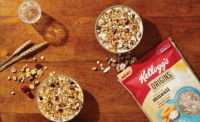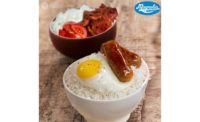Breakfast: Wake-up Foods
When creating new breakfast items, look for ideas from different cultures, groups and demographics.

Sophisticated offerings for today’s breakfast items are derived from ethnic cuisines that have had influential impacts in other meal channels.





There are seemingly an infinite number of prepared breakfast items available in today’s marketplace, yet breakfast appears to be the one meal many processors, outside those who focus exclusively on breakfast formulations, agree is the weakest category in their line-up. It is not only lacking the verve of volumetric sales, but also an area with which sales-to-cost ratios often are big disappointments.
Americans not only do not feel compelled to spend more than about $5 on a non-sit-down breakfast, the surge of offerings from fast-food establishments created a climate of competition that drove prices down into loss-leader territory. However, cheap and portable are two parameters that are stimulating enough revived demand to turn breakfast into a more demanded meal.
The daily meal known as breakfast can include a wide expanse of ingredients and components, depending on interpretation. This is only more pronounced in today’s polyglot society of dozens of cultural food traditions and the different stages of a fast-paced lifestyle consisting of hard work in the week and harder play on a weekend.
For a Hungarian immigrant, breakfast could be simply rough rye toast scraped with butter and chunky, homemade plum jam during the week. It can shift dramatically to extravagant use of smoked sausages, onions and potatoes, accompanied by (again) crisp rye caraway toast–often rubbed with raw garlic prior to being buttered.
A Japanese breakfast of miso soup and tofu with seaweed; a French breakfast of assorted pain -- sweet bread pastries -- and strong, milky coffee; or an Israeli breakfast of multiple offerings each of salads, cheeses, olives, fruits, pickled fish, yogurts and juices only touch on the challenges a processor has developing breakfast items to please all.
Whether a reflection of the comfort-food trend or a backlash against “everything low-fat,” sausage and bacon are enjoying a huge jump in popularity at the breakfast table. As a concept or an ingredient, sausage continues to please and remains at the top of the selection list internationally. Sausages are a “level-setting” breakfast meat. But, while bacon is busy being a trendy party-hopper -- showing up in places like chocolates, candy and ice cream -- sausage is staking more solid territory.
Sausages are flavor powerhouses, exploding with fat and garlic, and ingredients from assorted cuts and species of meat and various fillers and textures. Sausage -- essentially a meat emulsion -- also is easy to utilize. In its “truest” form, the link, sausage is a primary ingredient in manufactured breakfast goods, such as breakfast pies and sandwiches. The compact convenience makes it integral to handheld items favored in the grab-and-go lifestyle of the average American worker. In fact, “dashboard dining” has become one of the key drivers of new breakfast item concepts.
Morning Trends
The American Egg Board (AEB) pointed to several envelope-pushing breakfast trends recently. Dunkin’ Donuts rolled out a somewhat controversial Glazed Donut Breakfast Sandwich made with fried egg and cherry wood-smoked bacon inside a split glazed donut. Somewhat less controversial, but no less trendy, is the Garden Veggie Breakfast Sandwich at Au Bon Pain. It’s made with two fresh eggs, Cheddar cheese, caramelized onions, and fire-roasted red and yellow bell peppers, all served on ciabatta bread.
The AEB also noted that the Taco Bell chain is offering a breakfast “waffle taco” in some California locations. The item is made with scrambled eggs and sausage in a waffle that is folded like a taco and served with a packet of syrup.
The gluten-free trend made a huge impact on breakfast foods, make no mistake. Although only a small percentage of the population have true intolerance to the gluten protein found in wheat (and, for some, to barley and oat products), many have, for various reasons, chosen to avoid all gluten. When one considers the number of cereals, pastries, breakfast breads, pies etc., made with those grains, it would seem breakfast might have a hard time making it to the table. But, the trend has been a boon for new breakfast product development, even stimulating interest in the most important meal of the day.
One company working on this is Boulder Brands Inc., which now owns a large segment of the market share in commercial gluten-free baking. The company created a sweet, yellow corn flour English muffin that gets quite crisp when toasted. Cedarlane Natural Foods Co., already a trailblazer in the frozen breakfast category, created three gluten-free, egg-white frittata options for its Cedarlean line: Broccoli & Cheddar, Roasted Chile & Cheese and Spinach & Roasted Tomato.
Each Cedarlean breakfast is made with a scalloped potato crust; is high in protein and fiber; and has 200 or fewer calories. The eye-catching “gluten free” icon is easily located on the front of the package, helping consumers with gluten intolerance to quickly identify this benefit.
Through a combination of technology and culinary craftsmanship, artisan-quality foods are fast overtaking empty-calorie, sugary snacks passing as breakfast. Further, constant innovation in the world of healthy cuisine has landed squarely in the middle of the breakfast course. This is especially evident in the breakfast bar genre. Dried fruit, nuts and nut butters remain the “glue” of this category, literally as well as figuratively. The ability of combinations of such ingredients as almond butter and fig purée to bring a bar together is impressive, not only as it pertains to nutritional balance but in flavor, as well.
Breakfast also is getting a boost from cultural infusions. Look for more influences of South and Latin America with items like breakfast empanadas appearing. Or, new convenience forms of traditionally plated ethnic favorites might appear, such as Tejano-style migas with crisp tortilla-layered eggs in portable formats.
Spanish influence could also arise from the Old World, via the development of a heat-and-serve, single-serving version of the savory torta: a layered egg, pepper and potato dish. This sort of recipe also represents the growing national infatuation with peppers at breakfast, either in fresh and dried form or as chili pepper sauces.
On the East Coast, a resurgence in British comfort food a few years ago familiarized some Americans to garlicky grilled “bangers” (in short, fat sausages) served with “bubble and squeak” -- browned, chopped potatoes fried with cabbage and mashed peas, plus broiled tomatoes. This has yet to translate into a reheatable format.
Another high-protein breakfast offering, typical of Japan, includes such ingredients as grilled salmon or even a breakfast version of sushi, and could soon land on prepared food line-ups. Perhaps even Indonesian burbur (rice porridge) served with spicy chilies and sweet-smoky pork floss (dried shredded pork meat) might become familiar to U.S. consumers as popular ethnic breakfast offerings.
Portability Preferred
It’s no secret most dieting consumers target breakfast as the meal to skip. It becomes a point to sacrifice undesired calories; one of the challenges makers of savory egg- or meat-based breakfast items face is the perception that these ingredients are indulgent and, hence, high in calories. This is where creating a healthful grab-and-go, one-handed breakfast became one of the most desirable goals for first-meal provisioners.
The AEB released a report on breakfast trends last summer that included growth statistics for handheld breakfast items. Breakfast sandwiches grew 9% on fast-casual restaurant menus between 2010-2013. And, the incidence of breakfast wraps on QSR menus rose 140% between 2009-2012. As an example, AEB described how the TacoTime “fast-Mex” chain entered the portable breakfast market with no fewer than five breakfast burrito offerings, each one including scrambled eggs, its trademark “Mexi-fries” and Cheddar cheese—plus varying combinations of meats and sauces.
For the home consumer, companies such as Vitalicious Inc. have pushed the technical envelope, however, and created breakfast items that support a healthy lifestyle, without compromising on the organoleptic factors. Vitalicious already opened the portion-control floodgates with its pioneering line of 100-calorie muffin tops and brownies. Several years ago, the company introduced its heat-and-eat VitaSandwich breakfast sandwich in two flavors: Egg ‘N Cheese and Egg ‘N Cheese with Veggies. Yet, each quarter-pound sandwich, made up of egg whites and American cheese between two whole-grain English muffins, has only 150 calories. But, in those 150 calories are 14-17g of protein, 6-7g of fiber and only 1.5g fat and 22g carbohydrates. They’re fortified with 15 vitamins and minerals, have no preservatives and are certified-kosher.
Last year, AdvancePierre Foods Inc. introduced Fast Bites, its line of sausage-/chicken-centered breakfast sandwiches designed specifically for convenience stores. The product line was “value-priced for consumers to help drive in-store morning traffic and increase store sales.” The five Fast Bites sandwiches include a Sausage Biscuit, Sausage Sandwich on a bun, Sausage and Cheese Sandwich on a bun, Breaded Chicken Biscuit and Spicy Breaded Chicken Biscuit.
At the same time, J & J Snack Foods Corp. introduced its Tater Stuffers, a filled hash-brown line developed for the roller grill, although they also can be fried. The Tater Stuffers hash-brown potatoes are filled with breakfast favorites, such as egg and cheese, green peppers and onions, or poblano peppers.
The Tater Stuffer line was developed for convenience stores and other foodservice operators, in order to offer their customers a “flavorful, convenient, grab-and-go” item. The marketing focus is on the use of “real potatoes, eggs and cheese.”
Value-added, precooked egg products are available in a “multitude of convenient, precooked forms to offer manufacturers flexibility in creating ready-to-heat packaged items that require consistency and portion control,” according to the American Egg Board. The Board notes that “many types of egg products can be customized to include the addition of other ingredients, including herbs, spices, cheeses and diced vegetables.”
A.M. diners will always need big flavor to awaken taste buds and good nutrition to keep energized. For food product creators, this means breakfast will continue to be a great playground for development and innovation in the coming years.
Menu Maneuvers |
|
Foodservice market researcher Datassential focused on the breakfast segment in one of its Food Bytes e-newsletters (“The Breakfast Club”) and noted that this category “has shown impressive gains within the restaurant industry during the past few years, with key breakfast trends continuing to move into new and exciting territories.” The firm says QSRs and mid-scale eateries are taking an especially big bite out of the latest breakfast trends. Lately, they’re offering everything from creative egg dishes and starches to Mexican flavor fusions -- all while keeping popular attributes like health, portability and budget-friendliness front and center. Here are few key points:
Top Growing Breakfast Items Using Datassential’s MenuTrends platform, officials say the top five, fastest growing breakfast varieties (since 2008) are yogurt, frittatas, oatmeal, burritos and huevos rancheros. Datassential’s MenuTrends annually tracks more than 7,000 menus. Commentary: “Paying particular attention to menu items showing the most growth, it’s evident that each one represents a sub-trend in the industry -- frittatas representing an overall push toward creative egg dishes; yogurt and oatmeal representing consumers’ desire for healthful ingredients; sandwiches representing delicious portability; and huevos rancheros representing an embrace of Mexican flavors.” Egg Ingenuities on the Menu With items like frittatas, skillets and Benedicts showing significant menu growth since 2008, it’s no surprise that operators are scrambling (pun intended) to come up with one-of-a-kind egg dishes. In fact, as the previous table shows, egg variations beyond the usual omelet account for six of the top 12 menu items showing the most growth. Artisan To-Go: Redefining the Breakfast Sandwich Portable breakfasts from restaurants used to mean a very basic egg-and-cheese sandwich. Lately, operators offer customers the best of both worlds: convenient, on-the-go options made with premium ingredients. Sandwiches lead the portability category in terms of popularity. Chefs Draw Inspiration from Mexican Cuisine Another way restaurant chefs are catering to their patrons’ desires is by experimenting with new, bold flavors in the kitchen. For example, Mexican menu items are quickly becoming staples for breakfast at QSRs and midscales. |
Breaking Good: Some breakfast statistics from the American Egg Board and Mintel Inc.
- The number of QSR locations offering breakfast increased 45.5% between 2007-2012.
- 72% of consumers visit fast-food restaurants once a week or more, while only 49% visit fast-casual restaurants.
- Egg breakfast menu items have increased by 20% since 2007.
- In 2012, 46% of all breakfasts ordered at foodservice included a sandwich; in 1989, the number was just 23%.
- QSR locations represent 82% of all breakfast availability.
- Mintel research shows 64% of people have visited a QSR with their children for weekday breakfast in the past month, while only 44% of those without children have done so. Mintel believes that’s due to “mothers hurrying to get children ready for school, while also trying to prepare themselves for work and having little time to fuss over breakfast.”
- Bruegger’s/Einstein Bros. Bagels, Dunkin’ Donuts, Sonic, Starbucks and Jack in the Box are now offering all-day breakfast
- “Breakfast anytime” is increasing in popularity. According to QSR Magazine, a growing number of QSR chains are adding all-day breakfast.
- McDonald’s rolled out an “After Midnight” menu, making breakfast items available for 10+ hours daily at its 24-hour locations.
- Popeye’s Louisiana’s Best Breakfast is being tested in North Carolina, with items including Biscuits with Sausage, Egg and Cheese; Breakfast Wraps; Grits; and Country-Fried Steak or Chicken.
- Even subway sandwich shops are getting into the breakfast act. Cousins Subs Co. began testing breakfast at 13 of its Wisconsin locations last summer.
Looking for a reprint of this article?
From high-res PDFs to custom plaques, order your copy today!








